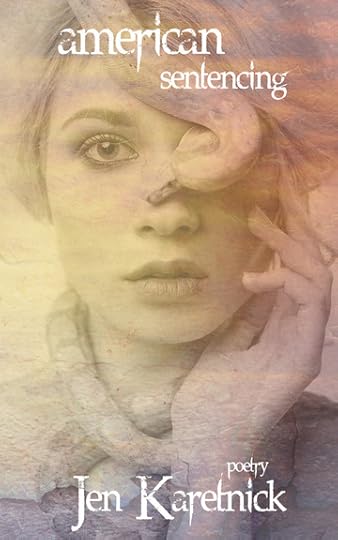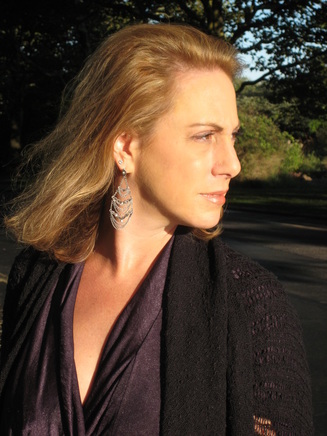Carpe Noctem Interview With Jen Karetnick
 Winter Goose Publishing, 2016 THINGS WE’RE DYING TO KNOW…
Winter Goose Publishing, 2016 THINGS WE’RE DYING TO KNOW…Let’s start with the book’s title and your cover image. How did you choose each? And, if I asked you to describe or sum up your book, what three words immediately come to mind?
The book’s title is a double entendre. Some of the poems, like the title poem, are similar to acrostic poems. Except instead of spelling out words, if you read them down vertically, the first word of every line forms a 17-syllable American Sentence, Allen Ginsberg’s answer to the haiku. The second meaning of the title refers to the range of invisible, chronic illnesses that many Americans, especially women, suffer from, and the lack of alleviation that Western medicine can do, or Western physicians seem to care, about it. I say this with a grain of smelling salts, of course, given that my husband is one of those physicians. So the cover features a portrait of a woman with a snake around her neck. A lot of people think she's Eve, and she can be thought of that way if you like—Eve was one strong woman. But it’s more meant to be a living symbol of the caduceus, a staff with two snakes wound around it, which is the representation of medicine.
What were you trying to achieve with your book? Tell us about the world you were trying to create, and who lives in it.
These 70-plus poems are about invisible, chronic illness, especially ME/CFS, autoimmune disease and bipolar disorder; the female body; and medicine from the points of view of patients, caretakers, spouses of physicians, and physicians themselves. One can be all of these things at the same time. For instance, I have both ME/CFS and autoimmune disease, while my husband also has autoimmune disease and my daughter has bipolar disorder. So we're caretakers and healers at the same time that we ourselves are often ill. But mostly I’m simply trying to raise awareness of how invisible illness works—that you can feel absolutely terrible, and be physically and mentally disabled, all while appearing perfectly fine to others.
Can you describe your writing practice or process for this collection? Do you have a favorite revision strategy?
This collection spans more than 20 years of writing. Invisible illnesses don’t go away, and I realized after a while that many of these poems weren’t going away either, so I collected the together and wrote new ones to fill in the blanks.
How did you order the poems? Do you have a specific method for arranging your poems or is it sort of haphazard, like you lay the pages out on the floor and see what order you pick them back up in?
I ordered the poems so that they tell the story of what it’s like to be sick from when I was a young woman just beginning to start a family to now, when my daughter has left for college and my son is in high school. One thing seeing these poems all together has taught me is that in the last two decades, many things have changed in the world of medicine, in my symptoms and treatments, in how I feel and view my illnesses, in how I’m willing to share knowledge about them without shame. Yet other elements have stayed exactly the same. For instance, many physicians now believe ME/CFS is a serious and often life-threatening disease that affects the neuro-endocrine-immune systems, and there are definitive ways to prove it by measuring cytokines, natural killer cells, viral loads and other functions. But there’s still no overall test for it and certainly nothing resembling a cure or even effective treatments, let alone the hope of them, simply because it has gone underfunded and unrecognized for so long.
What do you love to find in a poem you read, or love to craft into a poem you’re writing?
I love the surprise of a perfectly crafted image, and an insight I never would have expected or thought of myself. When I envy a poem’s language and want its syntax and diction for myself, I know I have found what Shelley referred to as that “first acorn, which contained all oaks potentially.”
Can you share an excerpt from your book? And tell us why you chose this poem for us to read—did it galvanize the writing of the rest of the collection? Is it your book’s heart? Is it the first or last poem you wrote for the book?
The title poem probably encapsulates the book, because it picks up all the frustration I’ve had getting diagnosed as a woman with nebulous diseases; even when my test results were positive, male doctors would tell me to go to the psychiatrist. It was a combination of my husband, who had watched me decline for years, and female physicians—a pair of lovely GPs, the high-risk OB for my son’s pregnancy and my immunologist, without whom I probably wouldn’t be writing, because I'd still be too ill—who finally put it all together. So this poem, about remembering there’s an art to medicine and not just science, and which I wrote towards the end of the process, is the nut of the book:
American Sentencing
Between you and me, there is no
doubt in your mind. I have been here before
and will be again for "pseudo-
gout," "reversible lupus," diseases ephemeral as
the skeptical blink. Unimpressive, you say. It is no
difference to you. Once again, a test outcome
is negative, as if I am less than the sum of zero,
a body that registers nothing, not even the pretzel
knot of all its parts. Look down my throat. Peer
in my ears. Allow your instruments to dictate
the truth as you have learned it --
joint connecting symptoms to diagnosis,
not the tissue of intuition, not
the fatty imagination, not the instinct of the
gut that is flexible and in no way demonstrable.
If you had to convince someone walking by you in the park to read your book right then and there, what would you say?
I’m a terrible salesperson, so I doubt I’d be able to convince anybody to do anything except call 911 by passing out on their feet.
I’ve heard poets say that they’re writing the same story over and over in their poems. Is that true for you?
I constantly write about mangoes, because I have 14 trees, and they give me way too much fruit to handle every season. They sneak into everything, even poems about illness. They’ve almost become a meme for me. And I suppose I will always write abut health issues, because I will always be sick, and my husband will always be sick, and so will my daughter. By the same token, we'll also be more well on some days than others, and we have no intention of feeling sorry for ourselves. So while I think poems about illness will creep up here and there, I hope there’s not another whole book of them forthcoming. My next three books are about completely different subjects (though the mangoes, I confess, appear here and there).
Do you think poets have a responsibility as artists to respond to what’s happening in the world, and put that message out there? Does your work address social issues?
I do, and my most recent work does attempt to address the refugee crisis in the Mediterranean, which I find heartbreaking. The chapbook manuscript that I just finished is written from the point of view of the boat that takes the migrants on their journeys.
Are there other types of writing (dictionaries, romance novels, comics, science textbooks, etc.) that help you to write poetry?
I enjoy writing found poetry, and I’ll use anything to do it—menus, lab reports, lesson plans, cookbooks. I also have been incorporating a lot of STEM theories into my work lately. I find myself really into knot theory, for example, even if I don’t quite understand it completely. Or even halfway.
What are you working on now?
I'm writing a spoken word play called SWAMP! that tackles many of the issues that the Everglades is facing: water quality, water quantity, habitat loss, nutrient and chemical pollution, light pollution, invasive species, and the threat of fracking.
What’s a question you wish I asked? (And how would you answer it?)
Why do I teach teenagers to write? Because no one else will. Just kidding. Because they are absorbent sponges and more in touch with themselves and their subconscious minds than most adults. They just need to be shown the way and encouraged, and sometimes bribed with food.
***
Purchase American Sentencing.
 Jen Karetnick is the author of three full-length books of poetry, including The Treasures That Prevail (Whitepoint Press, September 2016), and four poetry chapbooks. The winner of the 2016 Romeo Lemay Poetry Prize and the 2015 Anna Davidson Rosenberg Prize for Poetry, she has been nominated for “Best of the Net” and featured as a “Rock the Chair” poet of the week on Yellow Chair Review and as a Weekly Read for Red Bird Chapbooks. Her poetry, prose, articles and interviews have been published or are forthcoming in TheAtlantic.com, december, Guernica, Negative Capability, One, Painted Bride Quarterly, Prairie Schooner, Spillway and Verse Daily. She works as the Creative Writing Director for Miami Arts Charter School and as a freelance dining critic, lifestyle journalist and cookbook author.
Jen Karetnick is the author of three full-length books of poetry, including The Treasures That Prevail (Whitepoint Press, September 2016), and four poetry chapbooks. The winner of the 2016 Romeo Lemay Poetry Prize and the 2015 Anna Davidson Rosenberg Prize for Poetry, she has been nominated for “Best of the Net” and featured as a “Rock the Chair” poet of the week on Yellow Chair Review and as a Weekly Read for Red Bird Chapbooks. Her poetry, prose, articles and interviews have been published or are forthcoming in TheAtlantic.com, december, Guernica, Negative Capability, One, Painted Bride Quarterly, Prairie Schooner, Spillway and Verse Daily. She works as the Creative Writing Director for Miami Arts Charter School and as a freelance dining critic, lifestyle journalist and cookbook author.
Published on September 24, 2016 06:35
No comments have been added yet.



